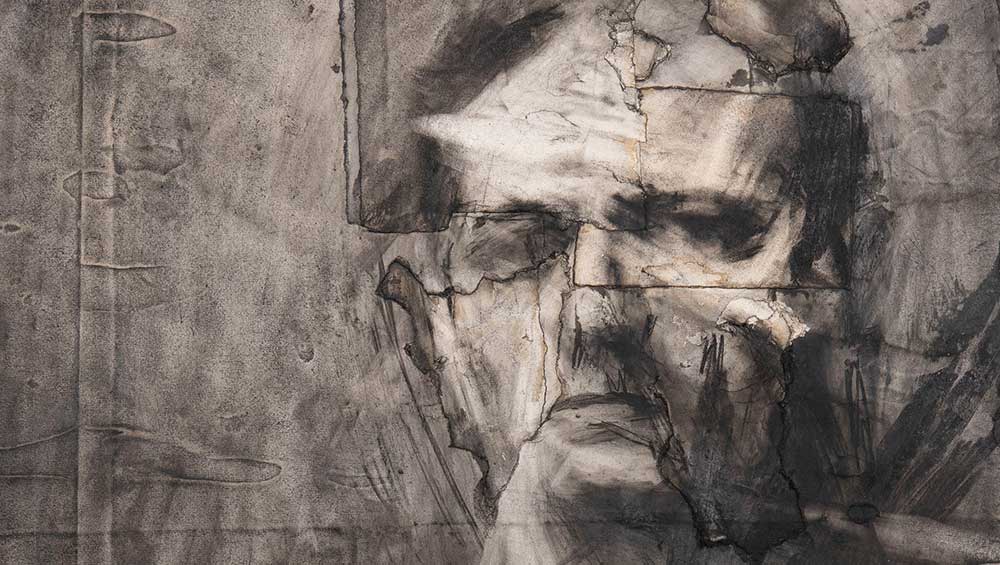
Frank Auerbach, Self-Portrait, 1958 (detail). Charcoal and chalk on paper. Private collection. © the artist, courtesy of Frankie Rossi Art Projects, London.
The Courtauld Gallery, London
9 February – 27 May 2024
by BETH WILLIAMSON
The 17 major charcoal drawings and six paintings that make up this succinct exhibition of portrait heads by Frank Auerbach (b1931) are powerful, tender and achingly beautiful renderings of sitters who were important to him and sat repeatedly for long periods. Made in the 1950s and 1960s when Auerbach was a young artist developing his practice, nearly all the works shown here emerged from the Mornington Crescent studio he has occupied in Camden since 1954. This north London location has been a constant in Auerbach’s artistic life, as have valued sitters such as Stella West, his lover for 23 years, (Estella Olive West [1916-2014], or EOW in Auerbach’s titles). Other sitters seen here include his friend the painter Leon Kossoff (1926-2019), his cousin Gerda Boehm (1907-2006), and his wife, Julia Wolstenholme (b1933), as well as emotive self-portraits that would not be repeated by the artist until much later in his life.
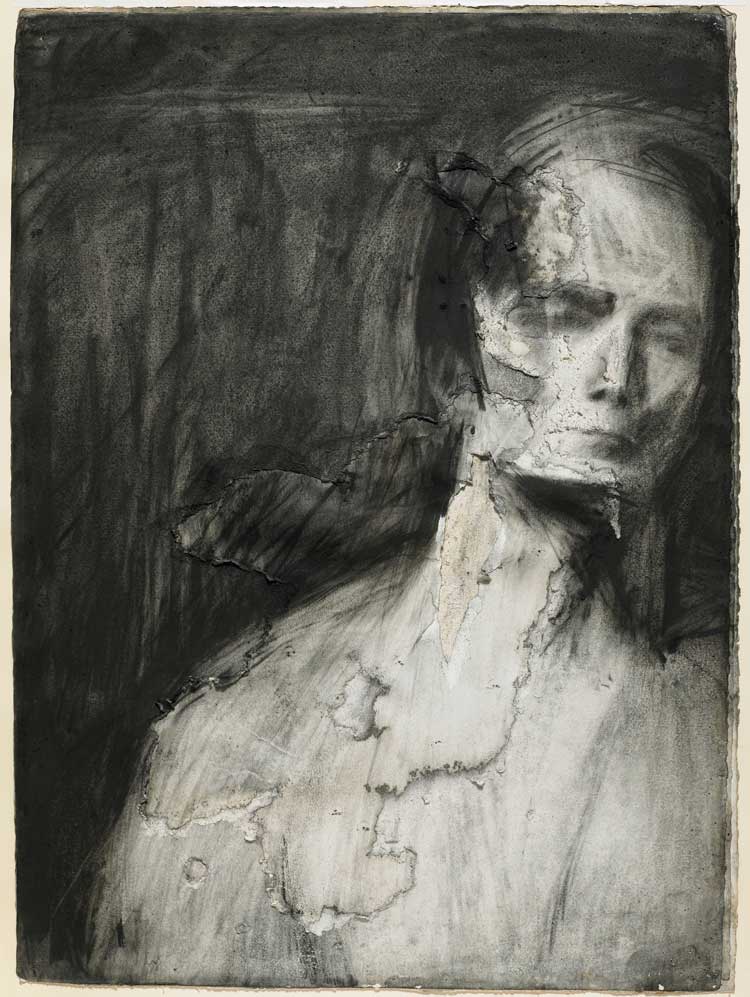
Frank Auerbach, Head of EOW, 1960. Charcoal and chalk on paper. The Whitworth, The University of Manchester. © the artist, courtesy of Frankie Rossi Art Projects, London.
It was Auerbach’s friendship with Kossoff, as well as life drawing classes he took with David Bomberg at the Borough Polytechnic Institute (now London Southbank University), that helped to form his commitment to drawing as a foundational aspect of his artistic practice. His devotion to drawing as much as to painting, is evidenced by these postwar charcoal heads, produced repeatedly and persistently for more than 70 years. These were not sketches or preparatory works for paintings, but large standalone drawings, credible images in their own right. As he has explained: “I was very concerned not to fritter my life away making sketches and studies and I tried to make something momentous.”
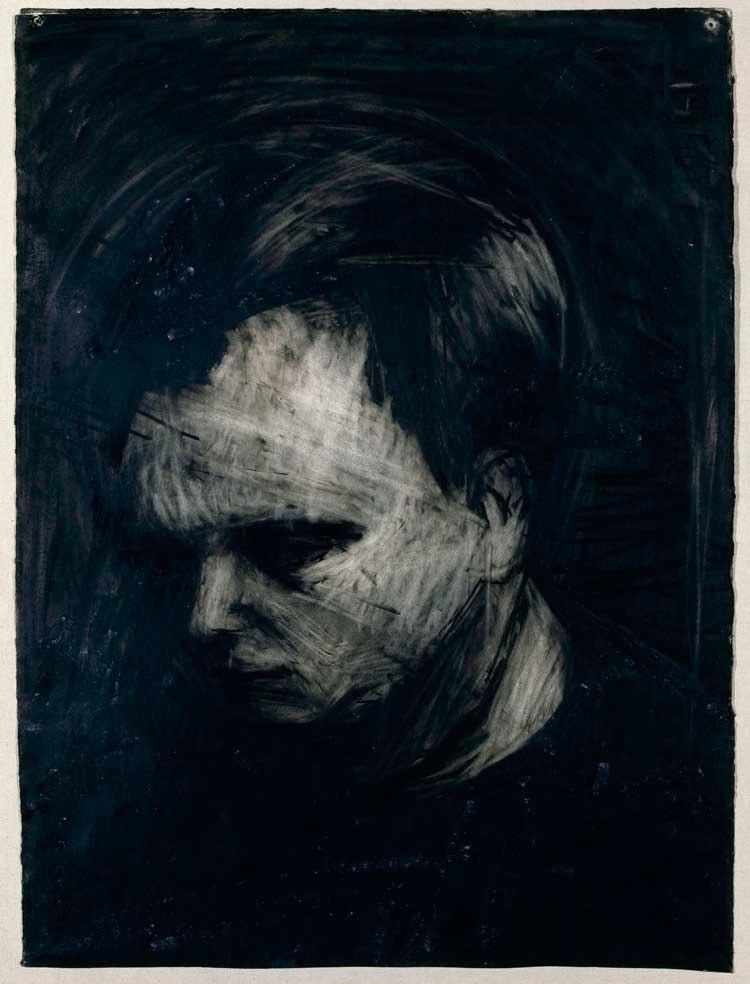
Frank Auerbach, Head of Leon Kossoff, 1956-57. Charcoal and chalk on paper. Private collection. © the artist, courtesy of Frankie Rossi Art Projects, London.
And these drawings are momentous, made over multiple sessions. Auerbach erased the entire drawing after each session, leaving a ghostly shadow from which to begin again in the next session. His repeated redaction and redrawing – perhaps 40 or 50 times – leaches through these heavily worked drawings, sometimes rubbed and cut through with white or red chalk, the paper torn and patched. The damage and erasure were not carelessness on the artist’s part. Instead, his deep desire to capture the essence of his sitters, to get to the very heart of who they were and to convey that, mean damage had to be retained in order to preserve the rawness of the drawings.
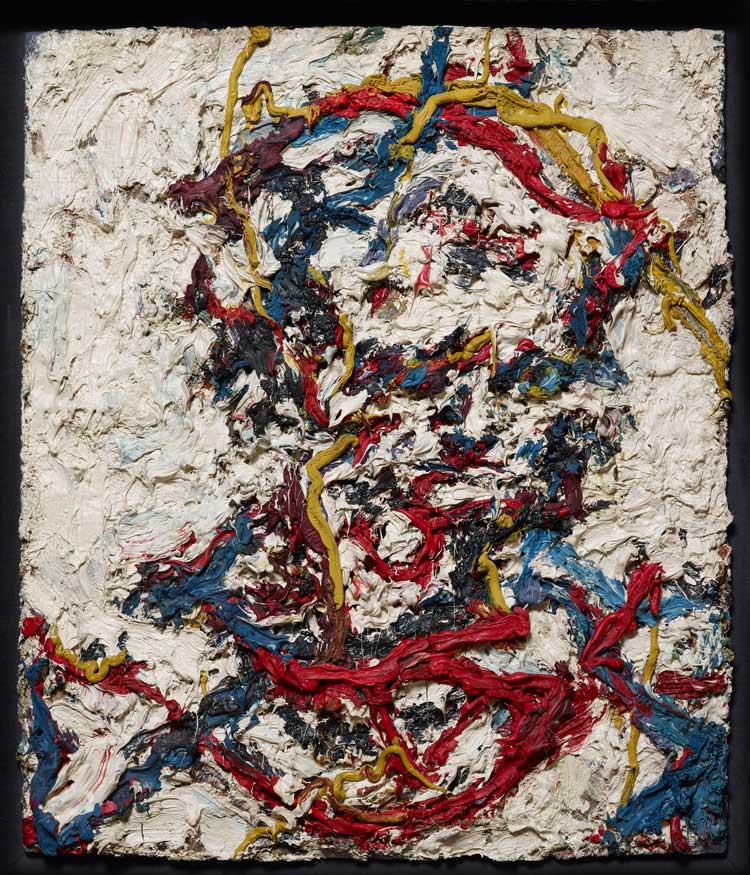
Frank Auerbach, Head of EOW III, 1963-64. Oil on board. Manchester Art Gallery. © the artist, courtesy of Frankie Rossi Art Projects, London. Photo: Michael Pollard.
The importance of the charcoal heads to Auerbach from the very beginning is underlined by the fact that his second solo exhibition at the Beaux Arts Gallery in London in 1957 was devoted to a group of these works – seven charcoal heads he had made of West in 1956 and 1957 and others he had made of Kossoff in the same period. This was the first ever showing of the charcoal heads, which appeared alongside paintings in subsequent exhibitions. Their vigour and intensity, the affinities between torn and repaired paper and torn and repaired skin, and a broader narrative of destruction and creation, all anchor them as products of their time made, as they were, just as lives and cities were being rebuilt after the second world war. While registering the fragility of humanity, Auerbach’s charcoal heads also convey the strength and vitality of human presence. As he explained: “I feel there is no grander entity than the individual human being … I would like my work to stand for individual experience.”
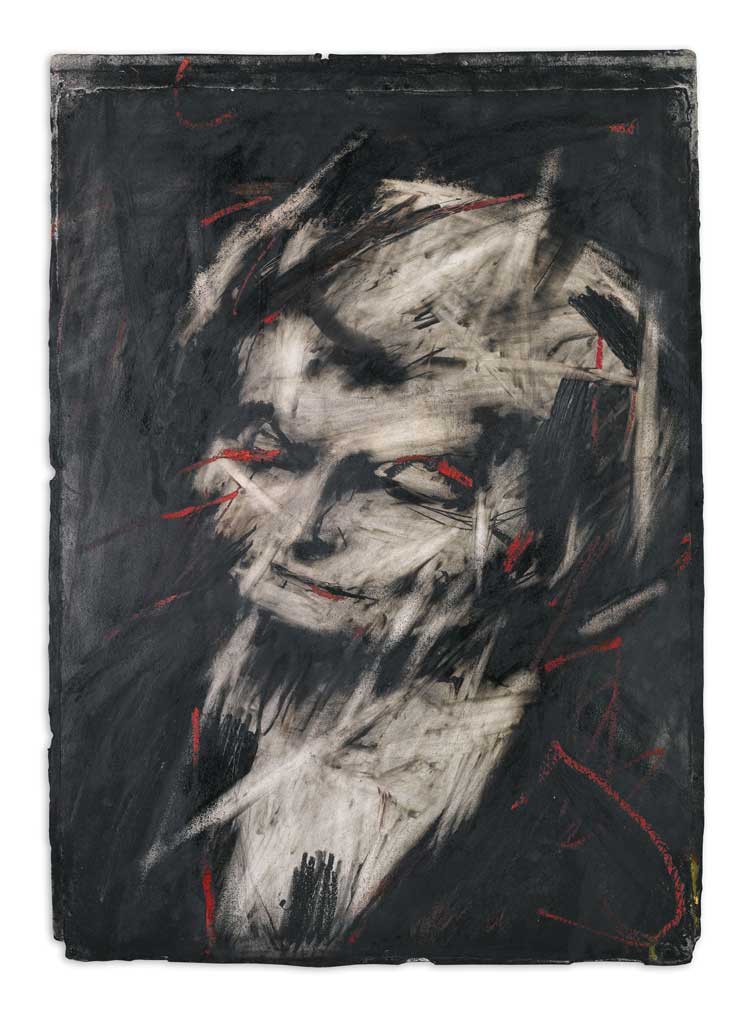
Frank Auerbach, Head of Helen Gillespie II, 1962. Charcoal and chalk on paper. Private collection. © the artist, courtesy of Frankie Rossi Art Projects, London.
Auerbach is relentless in his drawing, tearing, patching and redrawing. The energy he devotes to charcoal and paper is no less than that which he directs to oil paint and canvas, which makes sense when you realise that he has always wanted to make drawings with just as much power and impact as his heavily impasto paintings of the same subjects. Drawing sessions stretched into the night, and each work takes months for him to complete to his satisfaction. These were never quick sketches, but images made with the artist’s unfailing commitment to conveying his subjects with truth, tenderness and empathy. Repeatedly drawing the same sitters, especially those close to the artist, means that different drawings often portray different aspects and subtleties of their characters. Using shifting compositional approaches, Auerbach is able to bring out different aspects of his sitters’ characters.
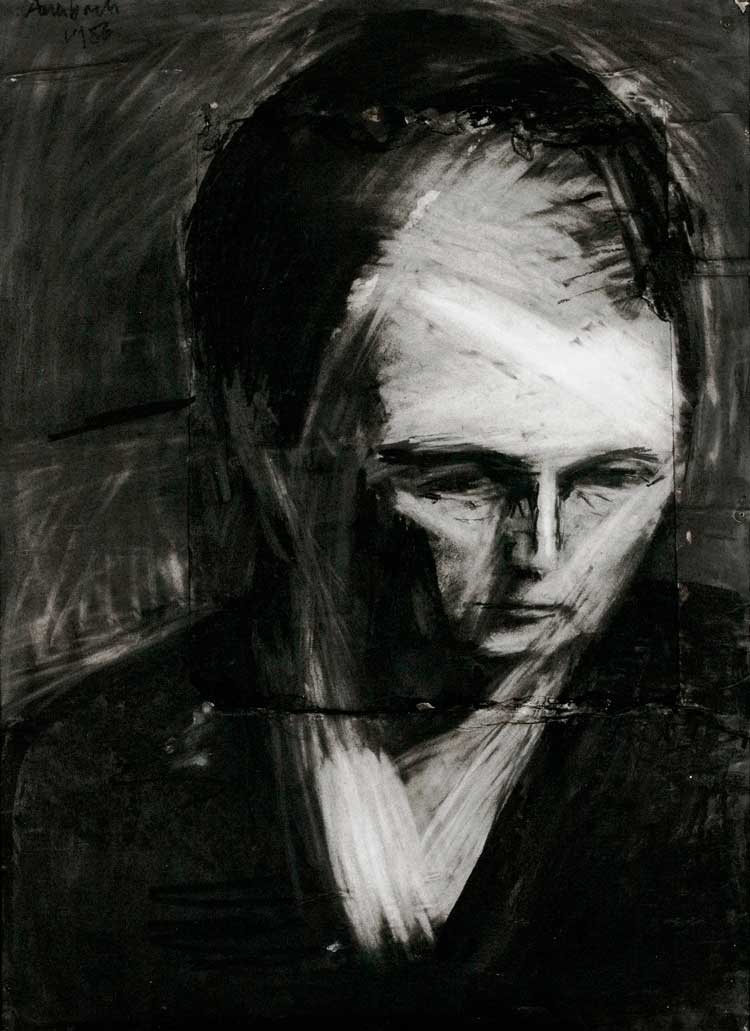
Frank Auerbach, Head of EOW, 1956. Charcoal and chalk on paper. Private collection. © the artist, courtesy of Frankie Rossi Art Projects, London.
In different drawings of West, for instance, he modulates the balance of dark charcoal and white chalk. One drawing in the exhibition, Head of EOW (1956) (loaned from the British Museum), shows West as if emerging from the darkness with her gaze directed downward and chalk used to emphasise her forehead. This gives the sense of the sitter’s forbearance. In another work of the same title that year (this time from a private collection), Auerbach used chalk and an eraser to cut through the charcoal. Creating bold diagonal lines and framing West’s face in starkly contrasting ways lends an energy to his subject and an intensity of presence, and character, that differs from the image previously discussed here. Later charcoal drawings of West in this exhibition, from 1960, deploy the gaze alongside accidental tears and patches of the drawing process, to suggest a more introspective demeanour. In yet further examples, he includes more of West’s body and a stronger sense of how she occupies the dark recesses of space, sometimes seeming to press out of the picture to meet the viewer. In his multiple charcoal drawings of Julia, one of the most bold and inventive in this exhibition is Head of Julia II (1960), with electrifying strikes of pink chalk added at the very end of Auerbach’s long process of drawing. This unusual approach results in a drawing that is deeply considered and spontaneous at one and the same time, something that lends it a particular energy it would not otherwise have.
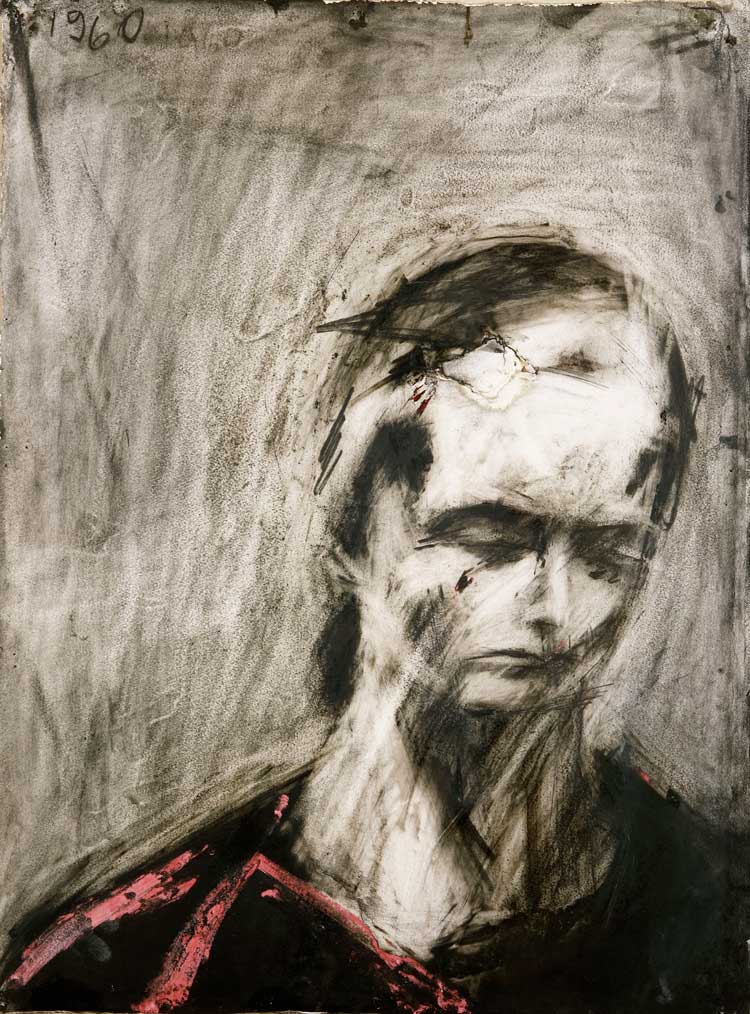
Frank Auerbach, Head of Julia II, 1960. Charcoal and chalk on paper. Private collection. © the artist, courtesy of Frankie Rossi Art Projects, London.
The depth of human experience and emotion that Auerbach manages to convey in these heads comes back to that intensity and vigour in his making. The broken paper, mended, drawn over and broken again, appears as a kind of psychological map, offering the possibility of even greater understanding of the inner life of his sitters. That brokenness never results in a fragmented or disjointed composition, but instead lends itself to the overall compositional coherence. There is a palpable sense of physical human presence, but there is also a profound sense of the human psyche, a living, breathing, emotional presence, too. There is an immediacy and an intimacy in these images that comes from the medium and from Auerbach’s deep connection with his sitters. It is an insight into that connection that visitors to this exhibition have the pleasure of sharing in.